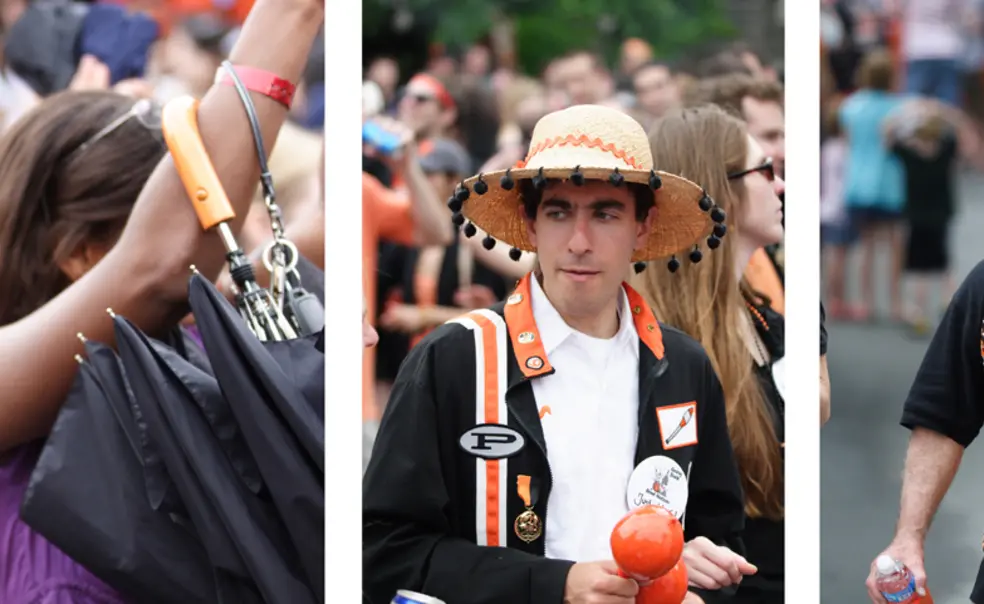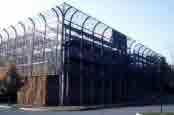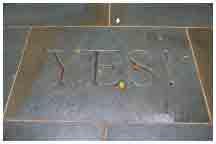Reunions recap
Reunions 2008 draws 20,000
With more than 20,000 alumni, family members, and friends attending Reunions Weekend, it may seem difficult for one person to stand out in the crowd. But Malcolm Warnock ’25, left, drew a remarkable amount of attention in Saturday's P-rade. Carrying the Class of 1923 Cane as the oldest alumnus at Reunions (for the fourth time), Warnock rode through campus to waves of applause and cheers. He is 102 years old, set to turn 103 later this month, and the next-oldest alumni in the P-rade were nine years behind him in school. But Warnock did not see reason for all the fuss. "I have received today more completely unwarranted attention than I have ever received in my life," he said.
Carrying the Class of 1923 Cane as the oldest alumnus at Reunions (for the fourth time), Warnock rode through campus to waves of applause and cheers. He is 102 years old, set to turn 103 later this month, and the next-oldest alumni in the P-rade were nine years behind him in school. But Warnock did not see reason for all the fuss. "I have received today more completely unwarranted attention than I have ever received in my life," he said.
The Class of 1983 led the P-rade as this year's 25th reunion class, and its reunion was the first to be held at Whitman College. Co-chairman Steve Simcox ’83 summed up the new site in one word: "spectacular." While bands played and class members danced in the Class of 1963 Courtyard, others found a spot for quiet conversations and coffee breaks a staircase away in the Chester Courtyard, where baristas were on duty from morning to midnight.
Photos by T. Kevin Birch
Remembering 1968
Forty years ago this week, the normally festive Princeton Reunions took on a sober tone as visitors mourned the assassination of Sen. Robert F. Kennedy. Kennedy's funeral train passed through Princeton Junction on Reunions Weekend, bringing the tragedy of the previous Tuesday evening even closer to the thoughts of alumni. The University cancelled the annual alumni baseball game and rerouted the P-rade to keep festivities on campus, ending the procession at Blair Arch, where the Alumni Association held what William A.B. Paul, the secretary for the Class of 1918, called in his PAW Class Notes column a "dignified meeting" followed by "thoughtful discussions about the turbulent conditions today and those student agitators who are so hard for old Princetonians to underst0and." Duncan van Dusen ’58 wrote in PAW's Class Notes that while Kennedy's death caused a drop in Reunions attendance, there were some positive returns for those who came to campus. "The modified schedule of events provoked much discussion about the future of the United States, where we are going, and where we ought to be going," he wrote. "Liberals, moderates, and reactionaries, all equally concerned, exchanged ideas without blows, often nearing agreement if not as to programs, at least as to the problems."
Answers to the Reunions 2008
Princetoniana Challenge
Congratulations to Ashley Prescott ’06 and Jonathan Sapan ’04, who each scored a perfect 10-for-10 on the Princetoniana Challenge. Both winners received copies of The Best of PAW: 100 Years of the Princeton Alumni Weekly, edited by J.I. Merritt ’66. For readers who were stumped by the quiz, an annotated list of answers is printed below.
Where is...
1. A building that once served as the nation's capitol for the Continental Congress?
Nassau Hall served as the headquarters of the Continental Congress from July-October 1783.  2. This display containing skeletons of a modern and a prehistoric tiger?
2. This display containing skeletons of a modern and a prehistoric tiger?
The skeletons of a modern Bengal tiger and of its evolutionary predecessor, a 28,000-year-old Smilodon or saber-tooth tiger, are on display at the Frist Campus Center, 100 level, by the windows at the rear. 3. The "Fountain of Freedom," in the center of which is one of the largest bronze castings in the world?
The Fountain of Freedom was designed by James Fitzgerald in 1966 and rises from the Scudder Plaza pool in front of Robertson Hall. 4. The grave of Nathaniel FitzRandolph, donor of Princeton's original campus?
It is under the eastern arch of Holder Hall and Rockefeller Hall, and there is a plaque explaining the significance of the site. FitzRandolph solicited donations of land and money and donated some of his own land as well. His family's burial ground was here.
5. This parking garage, which won a design award from the American Institute of Architects?
The parking garage is next to Bowen Hall at 70 Prospect Avenue (between Olden and Murray Place). Built in 1991 and designed by Machado Silvetti Associates (Boston), the garage won a design award in 1993 from the American Institute of Architects. 6. The statue of a dean who argued about the location of the Graduate School with a future president of the United States--and won the argument?
A statue of Andrew Fleming West (class of 1874), first dean of the Graduate School, is in the Thompson courtyard of the Old Graduate College. Although Woodrow Wilson, as president of Princeton, wanted to build the Graduate College in the main part of campus, West thought that it should have a separate location. West won the argument in 1910 when alumnus Isaac Wyman (Class of 1848) died, leaving a bequest that helped to fund West's plan. "We've beaten the living," said Wilson to his wife, Ellen, "but we can't beat the dead." 7. A building in the shape of an octagon?
The octagonal Chancellor Green building, designed by William A. Potter and dedicated in 1873 as Princeton's first freestanding library, is now part of the Andlinger Center for the Humanities.  8. This stained-glass window, called the "Seven Liberal Arts Window"?
8. This stained-glass window, called the "Seven Liberal Arts Window"?
The Seven Liberal Arts Window, designed by William and Annie Lee Willet, is at the west end of Procter Hall at the Graduate College. 9. A flag from the aircraft carrier U.S.S. Princeton IV, which sank during a battle in 1944?
The flag is in the University Chapel. It came from the aircraft carrier U.S.S. Princeton IV, which was commissioned in 1942 and had one of the most distinguished service records among Navy ships during World War II until it was sunk in 1944 during the Second Battle in the Philippine Sea. James Forrestal, class of 1915, presented the ship's flag to the University when he was Secretary of the Navy in 1944-45.
10. This word carved into the pavement?
This inscription is on the path from the Dinky to the new Whitman College. It refers to the wording of the letter sent to accepted applicants during the 1988-2003 tenure of Dean of Admission Fred Hargadon. A dormitory at Whitman College is named in honor of Dean Hargadon. Images courtesy of the Princetoniana Committee. Visit the Princetoniana section of the Princeton University Website for more Princeton lore.

















No responses yet